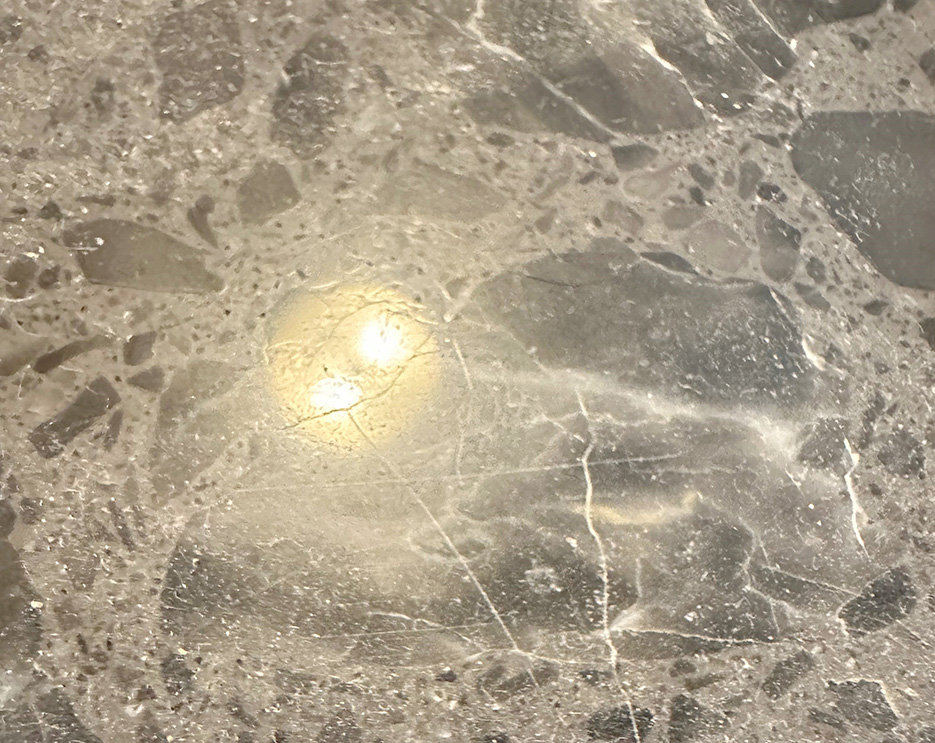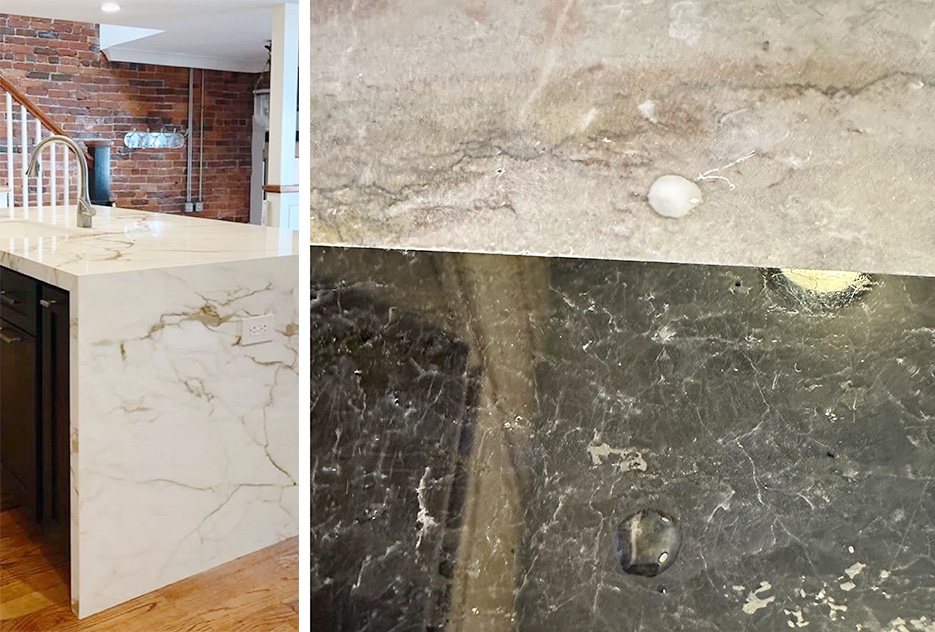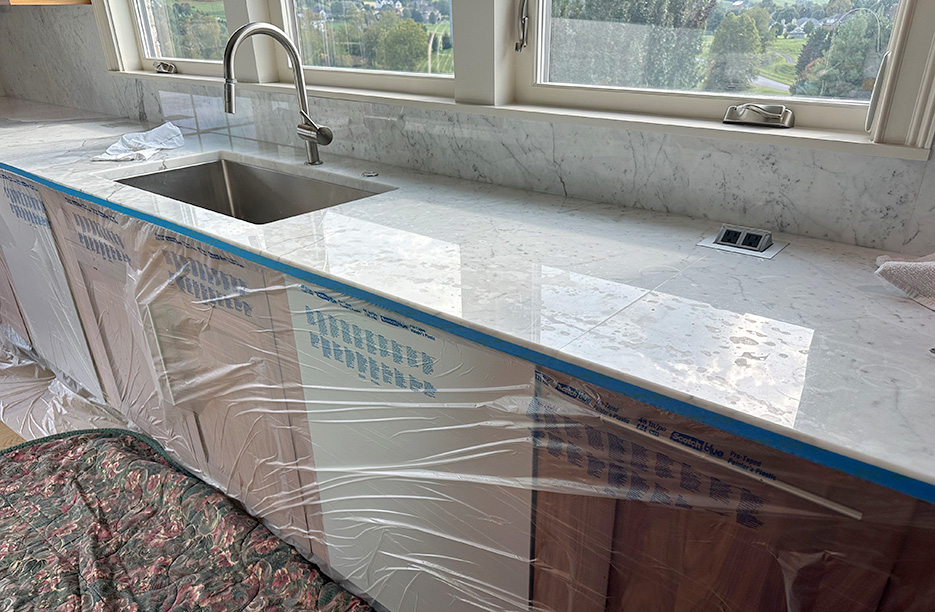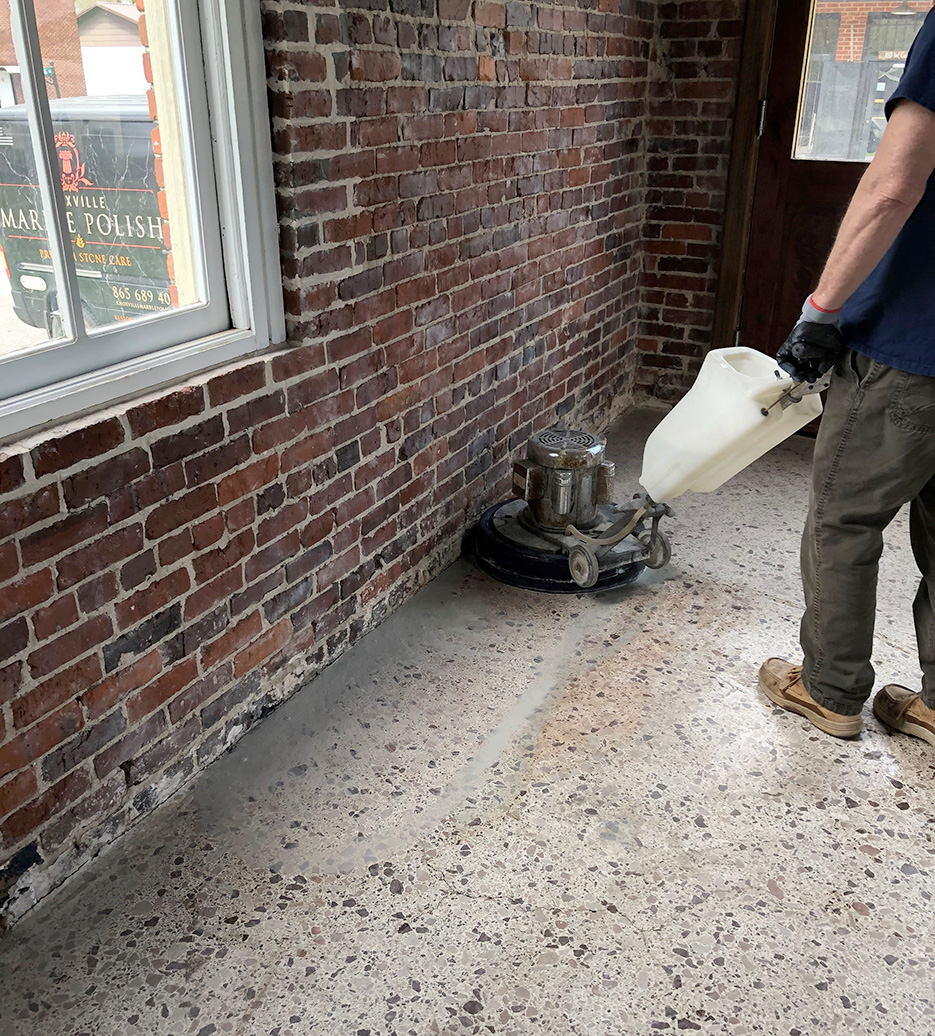Stone Restoration and Maintenance Corner – A Basic Geology Guide for Stone & Tile Pros
Bob Murrell
M3 Technologies
Photos by Bob Murrell
I’ve been in the stone industry for well over 45 years. I have taught the restoration and maintenance of natural stone, terrazzo, concrete, and ceramic tile for almost 40 years, and yes, I’m getting older, LOL! I was taught about the geology and chemistry, as it relates to natural stone, from both German and Italian engineers and technicians. 40 years ago, it was more straight forward than today as there was little to no engineered stone in the marketplace, much less the new porcelain products. Polishing concrete was a new and up-and-coming thing. There was no such thing as a purple (epoxy) terrazzo or porcelain countertops (solid tops, not from tiles).
It is imperative to understand the characteristics of natural stones and how they are formed and what minerals they contain in order to restore, protect, and maintain them correctly. If you do not understand the basics in chemistry and geology regarding the stones, you will never understand why we use different chemicals, and do certain things on different materials. So bear with me and let’s dive into it.
There are three basic types of natural stones: sedimentary, igneous, and metamorphic. Sedimentary stones are composed of layers which are settled upon each other over time. Igneous stones are composed of previously molten minerals or lava. Metamorphic stones are either of the first two categories which have then been folded and compressed over time by enormous amounts of heat and pressure. It is fair to say that most stone with veins or considerable movement are metamorphic. Limestone that has been metamorphosed eventually becomes marble. Granite that has been metamorphosed becomes gneiss.
 |
|
Engineered marble. Note the minor surface scratches. |
Marble, limestone, onyx, alabaster, travertine, terrazzo (both cementitious and epoxy-based), and concrete/cement are some of the materials that contain calcium. At the most basic level, there are two groups of stone in the world, those that consist of mostly calcium and those that do not. This is an extremely important concept to grasp. By understanding this, we can proceed to the procedures for each group.
Calcium carbonate is a metal salt (20 on Periodic Table) and very sensitive to acids. To test if calcium is present in a stone, simply place a drop of acid on the stone (in an inconspicuous area!). If the drop of acid effervesces (fizzes), the stone contains calcium. This is an etch. All calcium-containing stone will etch if subjected to an acid. The stronger the acid, the faster and deeper the etch. On metamorphic stone containing ample amounts of calcium, we can actually use acids to accelerate the polishing process. Most polishing products for marble and calcium-based stones contain a specific acid combined with micro-abrasives, which aids in producing a glass-like finish on the surface. Majestic 5X Gold is known as one the world’s best marble polishing powders.
Calcium-containing stone is generally softer than non-calcium containing stone, as well. Marble and limestone are somewhere between 3-4 on the Mohs hardness scale, while granite and similar stones are around a 7 on the Mohs scale. You can do an in-field test using a knife blade to see if the stone will scratch (test in an inconspicuous area!). The knife blade (steel) is around a 6.5 on the scale. The rule is it takes a higher number to scratch a lower number. The knife blade, at a hardness of about 6.5, will scratch marble (hardness of 3-4), but will not scratch the granite (hardness of about 7).
These two tests are the most common methods of determining the type of stone, and therefore determine the methods for restoring, polishing, and maintaining.
 |
|
Left: Porcelain center island. Horizontal and vertical pieces are 1/2 inch with a 45° miter joint to appear like thicker material.
Right: A drop of hydrochloric acid on marble (top-right picture) and on granite. Note that on the marble, the acid effervesces, and on the granite the acid has no reaction. |
|
Below: Marble countertop with etching all over the surface. |
 |
Of course, a visual inspection is another identification method as well. When it comes to other materials like engineered stones, terrazzo, concrete, and ceramic tiles, these same testing procedures are applicable in many situations.
Terrazzo, for example, is typically composed of marble and/or limestone chips in a cement or epoxy-based matrix. An acid test and a scratch test would confirm the presence of the calcium-based chips and cement. The resin in epoxy-based terrazzo will not react to the acid.
 |
|
Refinishing a cement-based terrazzo floor. Older terrazzo installations are more likely to have a cementitious binder instead of an epoxy binder and will affect your tool choices. |
Engineered stones are a newer addition to the hard surface scene. They have come on strong as a consumer-preferred material over the last 20 years. Quartz is one the most popular varieties and is very durable. Engineered quartz is composed of quartz (basically granite) and resin (normally an epoxy). These are the most common types. This group of man-made stones is very resistant to staining and scratching, similar to that of true granites. They are more sensitive to heat, because of the resin, and care should be taken to avoid setting hot pans directly on the surface. One advantage is that these stones do not have as much porosity as true granites, and are somewhat more resistant to staining, and therefore sealing is not normally necessary. We do have specific tools and polishing products for quartz materials like Quartz Renew.
However, there are also engineered marble stones, which exhibit the same characteristics of marble and limestone (calcium-based) stone. They will etch and scratch, just like marble. Because they are manufactured with an epoxy and marble, they do have the lower porosity and are more stain resistant and typically don’t require sealing or impregnating.
Porcelain is the newest and latest material used for many applications like countertops, floors, and showers. Porcelain is the Kevlar of hard surfaces! With new technology, manufacturers are now able to apply hundreds of tons of needed pressure to make porcelain countertop slabs. Countertops made from quality porcelain are the most durable countertops ever made. However, if the porcelain is honed, this can change the surface porosity by removing the original “skin.” But even so, the porosity is still less than .05%, whereas with marble and granite, the porosity can be anywhere from 1% to 5%, or more.
Each of these different materials are processed using different tools and chemicals, even though the basic concept of rubbing or honing from coarse to fine grit is similar. Be sure to verify your restoration equipment, tools, and chemicals to make sure you are approaching the situation with the right stuff.
As always and before beginning any new project, I recommend submitting a test area to confirm the results and the procedure, prior to starting a stone or hard surface restoration/maintenance project. Also, the best way to help ensure success is by partnering with a good distributor, like BB Industries, that knows the business. They can help with technical support, product purchase decisions, logistics, and other pertinent project information.
Bob Murrell has worked in the natural stone industry for over 40 years and is well known for his expertise in natural stone, tile, and decorative concrete restoration and maintenance. He helped develop some of the main products and processes which revolutionized the industry, and is currently the Director of Operations for M3 Technologies.
Send your comments and questions to Bob at attn:publisher@slipperyrockgazette.net .